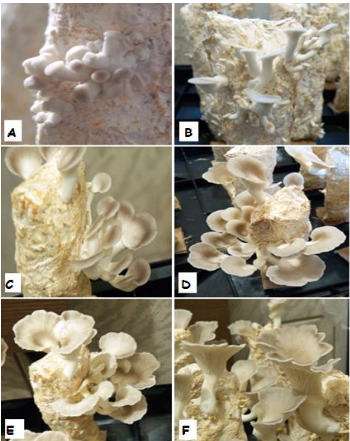Cultivation of edible mushroom Hiboukitake in caja bagasse by in Jun-Cao technique
DOI:
https://doi.org/10.20873/jbb.uft.cemaf.v4n2.pazKeywords:
Pleorotus sajor-caju, Spondias mombin bagasse, sugarcane bagasse, C/N ratioAbstract
Adapting to new waste to cultivate species of Pleurotus is currently one of the main processes of bioconversion of agro-industrial residues in edible products of high nutritional value. The present work, using the principle of clean technologies, cultured strain / lot EF-133/11 of Pleurotus sajor-caju on bagasse caja supplemented with crushed sugar cane. The biological efficiency (BE) obtained in Treatment 1 (T1 -composed of 70% bagasse sugarcane and 30% of bagasse caja) was 28.94 ± 3.62 and in Treatment 2 (T2 –composed of 50% bagasse sugarcane and 50% of bagasse caja) was 26.37 ± 5.01, these were not statistically different for the confidence interval of 95%, and the relationships C / N 52.00:1and 47.14:1, respectively. However it is perceived in a decay of BE T2, even with a high C / N ratio compared to T1, this feature is probably due to the fact that being a caja fruit, rather than the presence of pectin, which gives the bagasse a characteristic mucilaginous hindering gas exchange in the substrate and causing compaction. The standardization of cultivation bagasse cajá allows a reasonable BE can be used as a substrate for future commercial crops.

Downloads
Published
How to Cite
Issue
Section
License
Copyright (c) 2024 - Journal of Biotechnology and Biodiversity

This work is licensed under a Creative Commons Attribution 4.0 International License.
Authors who publish with this journal agree to the following terms:
Authors retain copyright and grant the journal right of first publication with the work simultaneously licensed under a Creative Commons Attribution License (CC BY 4.0 at http://creativecommons.org/licenses/by/4.0/) that allows others to share the work with an acknowledgement of the work's authorship and initial publication in this journal.
Authors are able to enter into separate, additional contractual arrangements for the non-exclusive distribution of the journal's published version of the work (e.g., post it to an institutional repository or publish it in a book), with an acknowledgement of its initial publication in this journal.
Authors are permitted and encouraged to post their work online (e.g. in institutional repositories or on their website) prior to and during the submission process, as it can lead to productive exchanges, as well as earlier and greater citation of published work (Available at The Effect of Open Access, at http://opcit.eprints.org/oacitation-biblio.html).


